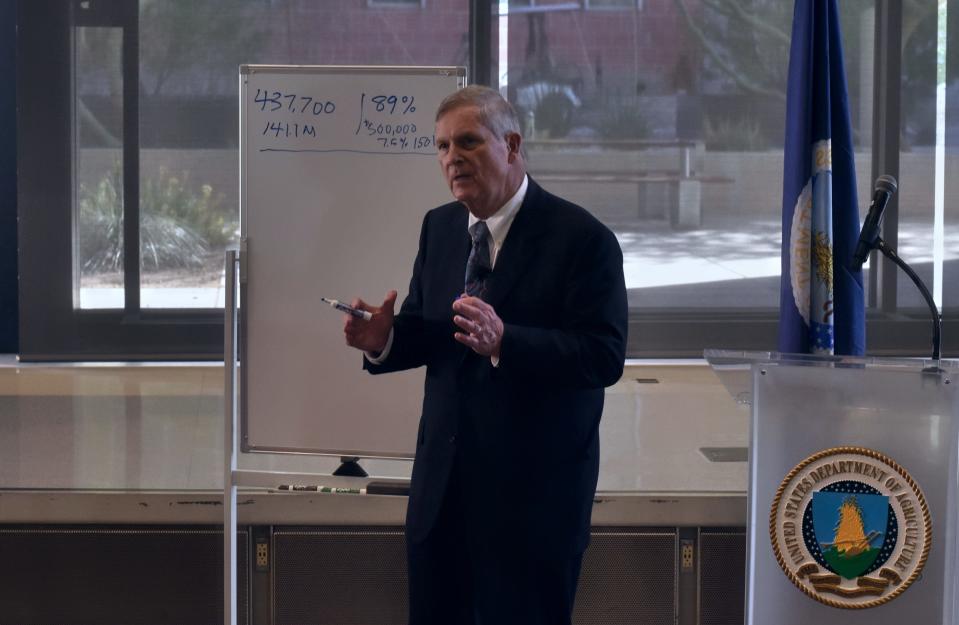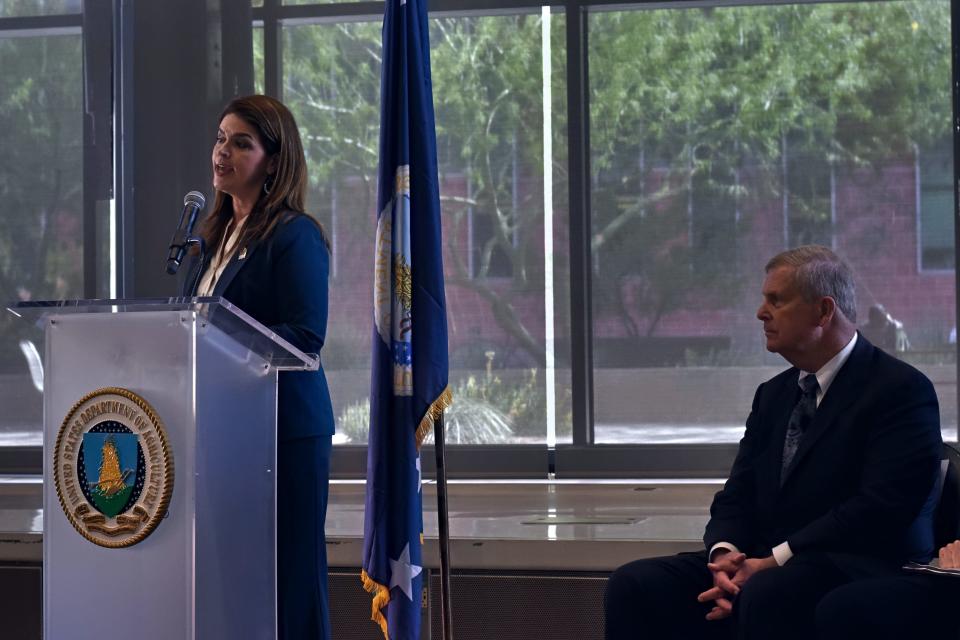Climate smart programs can help Arizona growers stay on the farm, ag boss Vilsack says
- Oops!Something went wrong.Please try again later.
TUCSON — U.S. Agriculture Secretary Tom Vilsack met with Arizona stakeholders on Thursday to underscore the vision and investments the agency is making to bolster local food economies and farm income through historic investments in “climate-smart" agriculture.
The funding and programs associated with it are part of a “new model or a new framework for small and mid-sized farming operations to stay in business,” said Vilsack.
He spoke at the University of Arizona’s Health Sciences Innovation building at an event that also drew Tucson Mayor Regina Romero and Arizona Department of Agriculture Director Paul Brierley, along with a host of panelists from academia, nonprofits, tribal nations, and the agricultural industry who shared how federal funding is at work in Arizona.
Over the next three to five years, the agency will dedicate additional funding to several programs that seek to strengthen energy, food production and supply chain systems in U.S. agriculture.
“Climate-smart agriculture creates new value, added opportunities, income streams," Vilsack said. "Local regional food systems create not only new income streams, but greater opportunities for farmers to have a greater share of the dollar, stay on the farm. And that money circulates in the community."
A big part of the investment, $20 billion total, went to the Natural Resources Conservation Service to expand conservation programs, which have been "historically over-subscribed and underfunded," according to the National Sustainable Agriculture Coalition. Two of the signature programs turned down 60 to 70% of all applicants.
Powering Affordable Clean Energy and Rural Energy for America Program are some of the other programs that make up the larger investment framework of the agency.
A Resilient Food Systems and Infrastructure program was one of the most recently announced investments. Arizona was awarded $4.6 million to roll out in competitive grants and equipment grants over four years. The Arizona Department of Agriculture is still analyzing the federal guidelines and will open applications in the near future, Brierley said.
A challenge to the 'get big or get out' model

Vilsack began his intervention writing two numbers in a small whiteboard: 437,700 and 141. That is the number of farms and the millions of acres of farmland that the country has lost since 1981, he told his audience.
At the core of the issue is a model that affords privileges to big players over small and mid-size operations.
Last year, the U.S. posted a national record in overall farm income.
"I couldn't understand how we could have a record year," Vilsack said. "At the same time, people were telling me that nearly 50% of our farmers lost money."
The Agriculture Research Service showed that about 92% of the farms, roughly 2 million farm operations, claimed 11% of that total income. The question, he said, is whether we are okay with that.
The beauty of having a robust five-year funding for these programs, said Vilsack, is that it "gives us an opportunity to establish this framework, so that as we negotiate the next farm bill, we will be in a position to articulate that there needs to be an alternative to 'get big or get out.'"
Highlighted grants and programs

The source of funding to invest in the administration's new framework includes the American Rescue Plan Act, Bipartisan Infrastructure Law, and Inflation Reduction Law. Some of the grants highlighted were:
A $70 million five-year grant to the University of Arizona focused on growing and processing guayule, a native desert plant that is an alternative source of rubber. Half of the funding came from USDA and half from the tire and rubber company Bridgestone.
A $10 million grant to the UA for agrivoltaics research, growing crops under solar panels, from USDA and the National Institute of Food and Agriculture.
A $5 million grant awarded to Arizona State University’s School of Sustainability to support future leaders in agriculture and food systems via scholarships and paid internships.
A $4.7 million grant to the Arizona Partnership for Climate-Smart Food Crops, made up of universities and nonprofits, to bolster climate-smart food production and promote new markets for those products.
Some of these grants are part of USDA's $3.1 billion Climate-Smart Commodities program, created with funding from the Commodity Credit Corporation.
Arizona is included in 13 of the 141 selected program projects. Some are exclusive to Arizona; others are shared with numerous states. The 13 projects, totaling over $300 million are for 17 different major commodities, including beef, dairy, natural rubber, specialty crops, and cotton. A summary of all the projects and lead partners can be found on the program website.
The 13 projects are “specifically tailored to Arizona or to the Southwest,” said Vilsack. “We don’t grow guayule in Iowa, but you do here.” Some other projects are consistent in all states, like fruit and vegetable projects.
Independent commission identified barriers to equity
Tucson was the last stop for the USDA's independent Equity Commission, which held six public meetings across the country to present the 66 recommendations for the federal agency to address discrimination, barriers to access, and inequity.
The commission started its work in February 2022. Its work examined denied applications and the main reasons behind rejections.
“We know for small farmers is really difficult to fill out our applications, they’re long, they’re tedious,” said USDA Rural Development State Director Charlene Fernandez.
The lack of technical experts to assist a wide variety of producers is also a barrier, said Gabriel Cruz, an egg producer.
“On my end, I have to do the research myself, put the proposal, generate the information," Cruz said. "Which I am not opposed to, but at the end of the day, I am also producing and managing business. I am also my accountant, and sales manager.”
“The impact it has on my operation to focus two or three months to focus to write a producer grant is very difficult.”
Rafael Tapia, director of tribal community connections with Local Arizona, agrees that much of the inequity has to do with resources.
“We know that there are communities that when these investments come through, they just pass us by,” said Tapia, who is also a member of the Yaqui tribe. Local First is a partner in one of the climate-smart partnership grant.
“It's not that there is not the intelligence, they know how to get things done," Tapia said. "It's just that sometimes we don't have the grant writers in our community or the technical experts to make the case.”
Cultural gaps are another challenge. Tribal communities have been doing “climate-smart” practices for centuries but don’t have the same language to refer to them, Tapia said.
Clara Migoya covers agricultural issues for The Arizona Republic and azcentral. Send tips or questions to clara.migoya@arizonarepublic.com.
You can support local journalism in Arizona by subscribing to azcentral.com today.
This article originally appeared on Arizona Republic: Ag Secretary Vilsack touts programs to help Arizona growers survive

